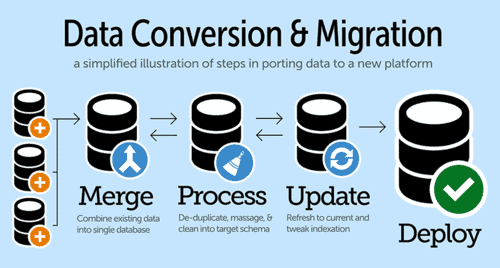
Data Migration Vs Data Conversion: How Are They Different?
During business management, you will come across instances where you may need to promote various datasets into a single database or directly from one CRM system to an entirely different one. You can make use of both data conversion and data migration to resolve challenges of such kind however many people confuse both terms often with the same purpose. This blog is all about detangling the myths and facts about data conversion and data migration and how these two terms are used interchangeably.
Data conversion is generally regarded as a significant part of data migration but a thin line separates the two terminologies. Data conversion is the transformation of information from one file format to another file format without the loss of data. On the contrary data, migration is associated with data transfer from the source system to a target system.
Companies investing in data migration services include Retail, BFSI, Defence, Government, Healthcare, IT, Media, Telecom, Manufacturing, Utilities, and other industries are included in the list as well. According to Persistence Market Research, the rise in business data volume can be linked directly to the adoption of the Internet of Things (IoT). Big data analytics is adding fuel to the growth of the data conversion and migration market.
Processes Involved in Converting and Migrating Data
Data Conversion Process
Data conversion is an essential process to take care of data load, review, and testing concerns by converting them into new databases and maintaining high data quality during the process. Once your data is tested and validated, you can easily convert it to another system to put it to instant use.
The main steps of the data conversion process include;
Data Review.
Identification of the source from which the data is collected.
Checking which important information is missing.
Properly translating and converting data.
Choosing the correct destination.
Data validation before the information is loaded into the new database.
To avoid getting stuck in numerous data conversion issues, it is better to consult the below-mentioned points beforehand;
Convert characters into printable data including the numeric information.
Create a neutral operating system or format to transfer objects into another data type.
Don’t forget to include header information in the converted data type to easily encode the remaining data.
To avoid any data-related challenges before they even take place businesses can deliberately rely on outsourcing their data conversion tasks. Experienced data scientists are adept at handling all kinds of data whether it is unorganized, unstructured, or inaccurate to make it more organized, easy to access, and business-friendly. Therefore, outsourcing data migration and conversion to the cloud or any other databases becomes a lot easier.
Data migration is an equally essential part of data management like data conversion. It deals in data transfer across various platforms benefiting your company’s infrastructure and storage capacity. When you intend to go paperless for the first time in history your company goes through a tough mess to handle on your own. An efficient data conversion service provider can fix this problem by switching your data to a new server. The ultimate business goal should be optimizing business performance at all levels.
Data Migration Process
The data migration process involves a series of steps such as –
Data review and data implementation in the prescribed manner.
Data mapping to locate possible data inconsistencies.
Tracing the tables in which data is located.
Identifying points where data can be migrated.
Safe data transfer of migrated data from target database to new database.
Data testing is carried out such that the information yields splendid output.
To avoid prospect data migration challenges make sure to keep in mind these tricks –
Ensure the data field exists in your new database which you used in the old database before performing a data migration.
Learn to deal with all types of file formats for convenience.
Take notice whether any data field combines during the process.
Companies gather huge piles of employees, customers, products, and digital assets information in their databases. When the systems get updated all the critical information will need to be stored in some other technologically advanced system. To perform successful data migration you can rely on a third-party service provider to improve your business competence and reduce overall data storage expenses. You will experience a new life in your business when things go according as planned through increased visibility of information at all times. Research shows that data migration is not an easy path to take as many companies fail in transferring their company data completely. Therefore, for the safe side, it is always good to develop a sound understanding of the data migration process and devise an effective plan to carry out the process with a reduced calculated risk percentage involved.
Preparation for Data Migration
If you plan to carry out data migration at your own expense make sure to follow the pre-data migration steps for desired results, these steps include –
Data mapping is done to create an analysis of the landscape to learn how data within a system is formatted.
Perform a data validation test on your data analysis to ensure whether the information matches your business objective or not.
Carry out data profiling to define what type of data you want to move and which type is no longer required and should be stored in archives.
Data Cleansing – An Important Step in Data Migration
The importance of data cleansing in data migration can not be over-emphasized enough. The process addresses inconsistent, faulty, and corrupted data by replacing it with well-formatted, accurate, and complete data within a dataset. Data cleansing includes –
Remove all unnecessary information within a dataset in the form of data duplicates or redundancies. Such information is of no use to your company and only takes up more space in your stored dataset.
By addressing missing information in your datasets you can fill in loopholes within your data and result in a complete dataset.
You can improve your existing or new datasets by removing inconsistent data and by correcting incomplete data before entering it into the new system. This step will appreciably improve your data quality during the data migration or data conversion process.
Data cleansing addresses all your data processing-related issues like the deletion of obsolete data and inappropriate data formats. It is an excellent way to verify data at hand and makes it more accessible, complete, and available in well-structured formats. When data cleansing is carried out you can now transfer your data safely to a new database. The data cleansing process is equally important in both data migration and data conversion process, this step is of exceptional importance in the industrial sector. If you are interested in ITS Database Development Services, you may ask for a free quote!





